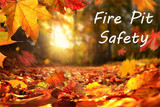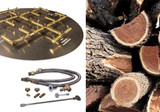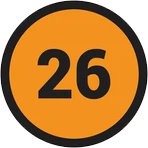Cooking Over a Wood Fire Pit
Here are some tips for grilling over wood:
Always use seasoned (dried) hardwoods like oak, alder, ash, beech, hickory, maple, pecan, birch, walnut, mesquite, or fruitwoods. Other options include olive wood, wine barrel staves, and grapevine clippings. (For obvious reasons, all are popular in northern California’s Napa Valley.) Softwoods like pine and fir produce a resinous smoke that generally spoils the flavor of food.

If you’ve ever built a campfire or started a fire in a fireplace, you know the drill: Create a teepee of small twigs atop a pile of kindling (wood chips, newspaper, or other tinder), adding larger pieces of wood as the fire catches. What you may not realize is that you can start a wood fire with a chimney starter. Fill the chimney with hardwood chunks and light as you would charcoal. Or light some charcoal in a chimney starter, and use it as an under-fire to bring the wood to flame.
To see our custom portable fire pits that you can grill over, plus when you add the optional cooking grate, you will have not only a fire pit but a way to savor the flavors of cooking over a wood source. A great inexpensive fire pit to cook over are the patina fire pits.
Allow plenty of time—up to 45 minutes—for the fire to mature and burn down to embers. Then, with a shovel or long-handled grill hoe rake the glowing orange embers underneath the grill grate. As with charcoal, the deeper the pile, the higher the heat. A common misconception among wood fire beginners is that cooking should be done over leaping flames. Note: The exception to the rule is Germany’s Spiessbraten, an onion-stuffed pork shoulder roast spit-roasted directly in the flames of a smoky beech wood fire. But in most wood fire-obsessed cultures, embers are the goal. Replenish as needed. In South America, log fires are built in a special wrought-iron rack called a leñero bracero; embers are harvested when they fall through the spaces at the bottom. A regular fireplace grate makes a reasonable substitute.
Wood burns faster than either lump charcoal or charcoal briquettes. Be prepared to replenish the embers every 20 to 30 minutes.

Open fires, i.e., those built on the ground or in a pit, are disallowed in many areas. Check with local authorities before your grilling session. An indoor wood-burning fireplace is also an option if you want to experiment with grilling over wood.
Of course, you’ll build your wood fire well away from anything flammable, including buildings, trees, spreading tree roots, dry vegetation, etc. Be sure to take note of wind direction and velocity. You don’t need to be a Californian to know that wind-driven fires can have tragic consequences.
Keep a fire extinguisher, water hose, a bucket of salt, or a pile of dirt and a shovel nearby to keep the fire from spreading out of control. (Hey, things can happen fast.) Extinguish the fire completely once you are finished with it. If you’ve built the fire in a charcoal grill, starve it of oxygen by putting the lid on and closing all the vents. If the fire has been built in an open area, douse it thoroughly with water (watch out for rising steam) or smother it with dirt. Tend the site for at least 30 more minutes to ensure the fire is completely out. (Remember “Smoky the Bear” and his public service words of wisdom?)
Incidentally—because I know some of you will ask—while wood fires send more particulate matter into the atmosphere than cleaner-burning propane, the Environmental Protection Agency does not currently endorse one over the other. Scientists say a fallen tree will release carbon dioxide into the air whether it is burned or left to rot, and over its lifetime, will have efficiently converted CO2 to oxygen. Unlike natural gas, wood is also a renewable resource. If possible, find a local source for grilling and smoking wood.
Fire Pit Tips, Product Guides & Outdoor Living Advice
Fire Pit Materials: Carbon Steel, Brass & More
Let’s face it: outdoor gatherings and fire pits go together like s’mores and marshmallows. There’s s...
The Ultimate Guide to Fire Pit Sizes and Materials
If you’re reading this, chances are you’re imagining cozy nights by a dancing fire under the...
Fire Pit Safety Tips Every Homeowner Should Know
There’s something undeniably magical about kicking back in your backyard next to a warm crackling fi...
Gas vs Wood Fire Pits: Which One Fits Your Lifestyle
If you're thinking about adding a fire pit to your backyard, you’ve probably run into the classic de...
How to Choose the Perfect Fire Pit for Your Outdoor Space
Creating an inviting outdoor living area has never been more popular, especially as homeowners seek...
The Proper Gas and Wood Fire Pit Height - The Best Seating Guide for Comfort
Outdoor fire pits are a beloved focal point for patios, backyards, and gathering spaces. Whether fl...








